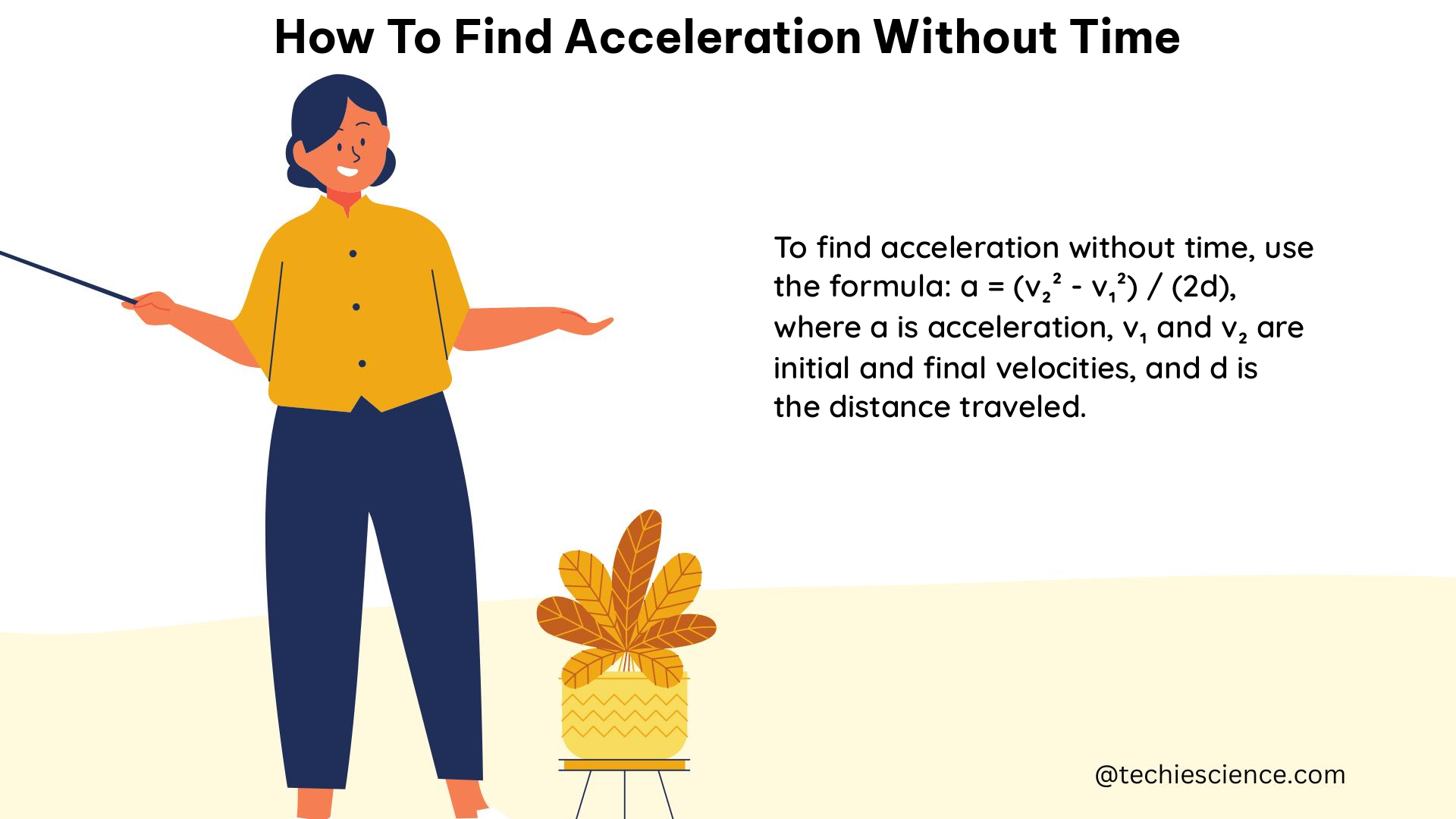Calculating acceleration without the knowledge of time is a valuable skill in physics, particularly when dealing with scenarios where time measurements are not readily available or practical. This comprehensive guide will delve into the underlying principles, formulas, and practical applications to help you become proficient in this essential technique.
Understanding the Kinematic Equation
The foundation for finding acceleration without time lies in the kinematic equation:
v^2 = v_0^2 + 2a(r_0 - r)
Where:
– v is the final velocity
– v_0 is the initial velocity
– a is the acceleration
– r_0 is the initial position
– r is the final position
This equation describes the relationship between the initial and final velocities, the acceleration, and the displacement of an object undergoing constant acceleration.
Deriving the Acceleration Formula

By rearranging the kinematic equation, we can derive the formula to calculate acceleration without time:
a = (v^2 - v_0^2) / (2(r - r_0))
Where:
– a is the acceleration
– v is the final velocity
– v_0 is the initial velocity
– r is the final position
– r_0 is the initial position
This formula allows us to determine the acceleration of an object based on the known initial and final velocities, as well as the displacement.
Applying the Formula: Examples and Numerical Problems
Let’s explore some practical examples and numerical problems to solidify your understanding of finding acceleration without time.
Example 1: Projectile Motion
Suppose a projectile is launched with an initial velocity of 50 m/s at an angle of 30 degrees above the horizontal. If the projectile reaches a maximum height of 25 meters, calculate the average acceleration during the ascent.
Given:
– Initial velocity (v_0) = 50 m/s
– Displacement (r - r_0) = 25 m (maximum height)
– Final velocity (v) = 0 m/s (at the peak of the trajectory)
Plugging the values into the formula:
a = (v^2 - v_0^2) / (2(r - r_0))
a = (0^2 - 50^2) / (2 * 25)
a = -25 m/s^2
The negative sign indicates that the acceleration is directed downward, as expected for the upward portion of the projectile’s trajectory.
Example 2: Braking Distance
A car is traveling at a speed of 80 km/h and needs to come to a complete stop. If the car travels a distance of 20 meters before coming to a stop, calculate the average deceleration.
Given:
– Initial velocity (v_0) = 80 km/h = 22.22 m/s
– Final velocity (v) = 0 m/s
– Displacement (r - r_0) = 20 m
Plugging the values into the formula:
a = (v^2 - v_0^2) / (2(r - r_0))
a = (0^2 - 22.22^2) / (2 * 20)
a = -24.64 m/s^2
The negative sign indicates that the acceleration is in the opposite direction of the motion, which is the case for deceleration.
Numerical Problem 1
A ball is dropped from a height of 50 meters. If the ball reaches a velocity of 30 m/s just before hitting the ground, calculate the average acceleration during the fall.
Given:
– Initial velocity (v_0) = 0 m/s
– Final velocity (v) = 30 m/s
– Displacement (r - r_0) = 50 m
Plugging the values into the formula:
a = (v^2 - v_0^2) / (2(r - r_0))
a = (30^2 - 0^2) / (2 * 50)
a = 9 m/s^2
The positive sign indicates that the acceleration is in the same direction as the motion, which is the case for free fall.
Numerical Problem 2
A car is traveling at a speed of 60 mph (26.82 m/s) and needs to come to a complete stop within a distance of 40 meters. Calculate the average deceleration.
Given:
– Initial velocity (v_0) = 26.82 m/s
– Final velocity (v) = 0 m/s
– Displacement (r - r_0) = 40 m
Plugging the values into the formula:
a = (v^2 - v_0^2) / (2(r - r_0))
a = (0^2 - 26.82^2) / (2 * 40)
a = -18.01 m/s^2
The negative sign indicates that the acceleration is in the opposite direction of the motion, which is the case for deceleration.
Limitations and Considerations
It’s important to note that the formula a = (v^2 - v_0^2) / (2(r - r_0)) is applicable only for objects undergoing constant acceleration. In cases of varying acceleration, this formula can be used to calculate the “average” acceleration, which represents the total change in velocity over the total change in distance.
Additionally, when using this formula, it is crucial to ensure that the units are consistent and that the initial and final velocities, as well as the displacement, are accurately measured or known.
Conclusion
Mastering the technique of finding acceleration without time is a valuable skill in physics. By understanding the underlying kinematic equation and the derived formula, you can confidently solve a wide range of problems involving constant acceleration. Remember to practice with various examples and numerical problems to solidify your understanding and become proficient in this essential skill.
References
- How do you work out average acceleration without time?
- Calculate average acceleration without time
- Using Kinematic Equations to Solve for an Unknown Acceleration

The lambdageeks.com Core SME Team is a group of experienced subject matter experts from diverse scientific and technical fields including Physics, Chemistry, Technology,Electronics & Electrical Engineering, Automotive, Mechanical Engineering. Our team collaborates to create high-quality, well-researched articles on a wide range of science and technology topics for the lambdageeks.com website.
All Our Senior SME are having more than 7 Years of experience in the respective fields . They are either Working Industry Professionals or assocaited With different Universities. Refer Our Authors Page to get to know About our Core SMEs.